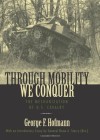Through Mobility We Conquer: The Mechanization of US Cavalry
Written by: George F Hofmann,
University of Kentucky Press, Lexington, 2006,
ISBN: 9780813124032, 578 pp.
Reviewed by: Jean Bou
The mechanisation of ground forces was one of the most important developments in twentieth century military affairs. George F Hofmann, a former Armored Branch officer in the US Army and now a Professor of History at the University of Cincinnati, has sought to explain how the US Cavalry underwent mechanisation, a process which was fraught with difficulties for many armies. Hoffman’s focus is on the ‘lessons’ of the First World War (or at least of the Western Front), the experiences and views of key officers, the demands and limitations of technology, budgetary restraint and, whether the United States made suitable preparations for the next World War.
Hoffman begins his analysis with the US Cavalry in the First World War. While few officers saw battle in their pre-war mounted role, some began to conceive that formations built around armoured units might be the way of the future. Such men, who generally advocated some form of ‘deep’ manoeuvre battle at the operational level, soon found themselves in an inter-war army which, by Hofmann’s telling, was dominated by General John Pershing’s belief in infantry-based ‘open warfare’ over broad fronts, maintained by a tight-fisted and isolationist Congress, and dominated by infantry and cavalry chiefs determined to control their respective armoured fiefdoms. Hofmann follows the inter-war arguments and military politics through to the raising of a dedicated Armored Force just before the US entry to the Second World War, and then examines the performance and experiences of mechanised cavalry in Europe and in occupied Germany afterwards.
Through Mobility We Conquer is obviously well researched, yet Hoffman’s often valuable observations are frequently difficult to follow in what is an unnecessarily long book. Its 471 pages of narrative could have been much less. Hoffman’s chapter on the US occupation of Germany seems to have little bearing on the central matter of mechanisation. The two Second World War chapters usefully highlight the mechanised cavalryman’s dilemma of having anticipated a ‘sneak and peak’ reconnaissance role, and then being required to shoot it out with the enemy on the battlefield, but they could have done so more pithily The chapters dealing with the period 1917-41 are the most important and the most interesting, but even here it can be heavy going. Hoffman’s efforts to inject colour with anecdotes on, for example, a junior officer’s son burning down the commanding officer’s dog house or the dubious qualities of General Adna Chaffee’s personal pilots, all too often only serve to obscure the main themes. Many chapters amble rather than purposefully get to the point.
Throughout the book is a traditionalist versus reformers theme. Unfortunately here Hoffman seems to have fallen into a trap that has captured many examiners of institutional change—that the would-be reformers were so obviously right, even at the time. This leads Hoffman to sometimes simplistic characterisations; those supporting the horse are unimaginative, blimpish types, while those in favour of mechanisation are clear-eyed visionaries. This is too black and white. The path ahead may seem obvious now, but was unlikely to have been so self-evident in 1918, 1925 or even 1935, and one suspects that apart from a few die-hards on either end of the spectrum most thinking officers held considered in-between views. A fuller appreciation of this would have helped the book and reflected the difficulties of a complex problem.
Through Mobility We Conquer has been well received in the United States, and received a prize from that country’s Army Historical Foundation. Hoffman provides an often fascinating insight into how the US Cavalry grappled with the problems of mechanisation in the inter-war years. Frustratingly, it is also a book in which the salient matters are often obscured by unfocused, often overlong chapters. Good history should also be good reading and by that standard this book does not hit the mark, but for those with a particular interest in mechanisation, army organisational change, and who have the time to wade through it, there are useful and well-considered arguments to be found.

